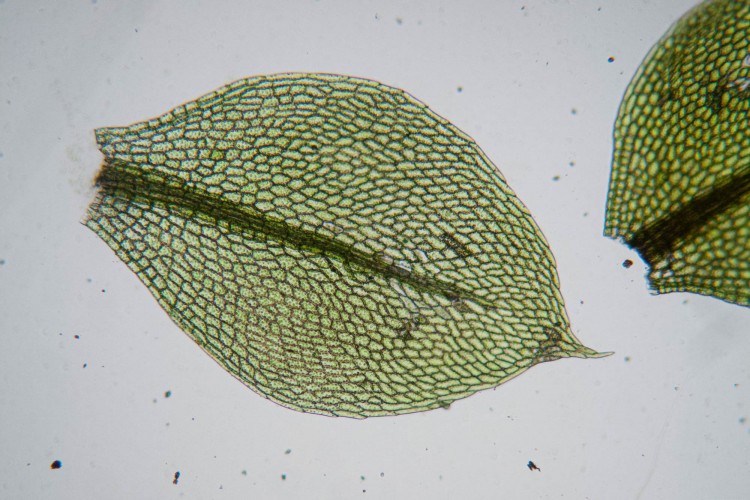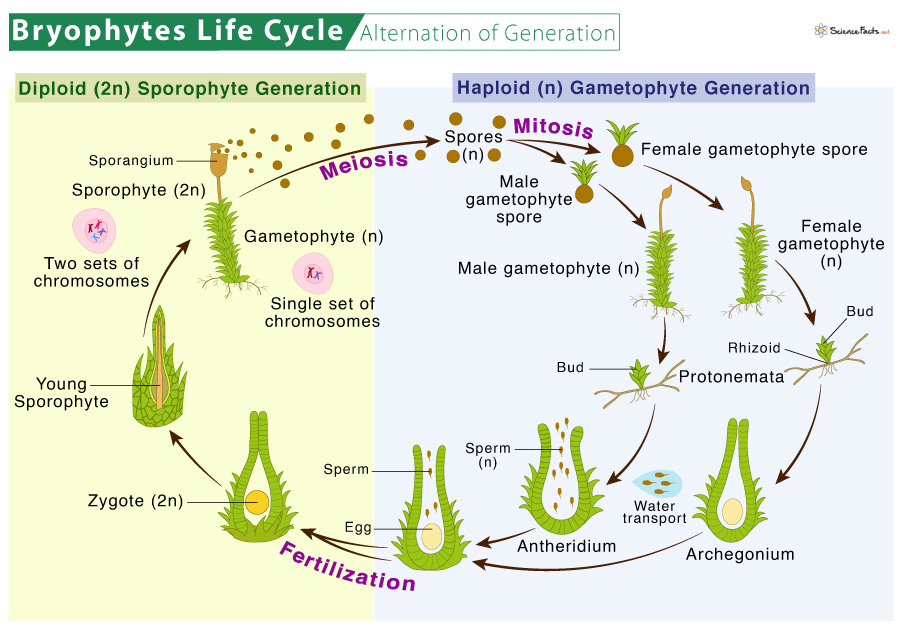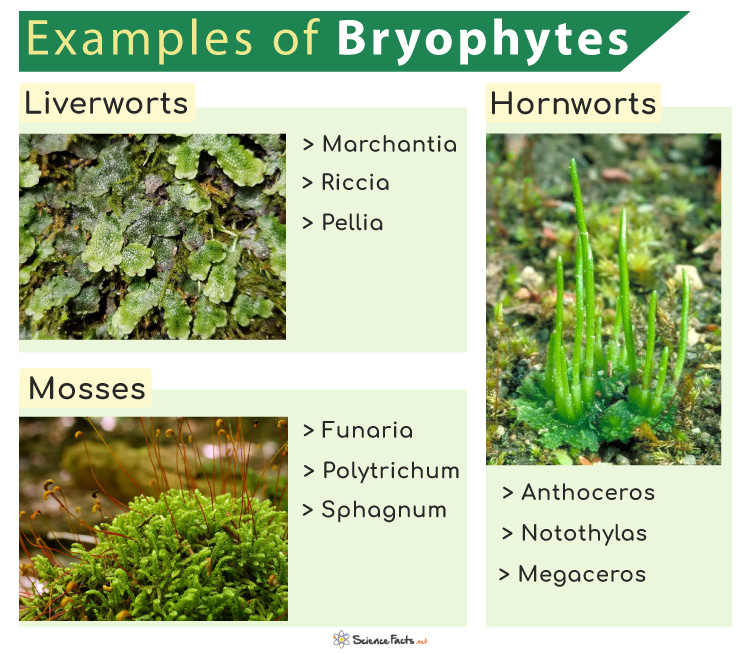According to the taxonomic division, bryophytes are divided into three main groups: mosses, liverworts, and hornworts. There are around 20,000 species of Bryophytes. Braun first suggested the term ‘Bryophyta’ – a group of non-flowering land plants in 1864. Wilhelm Schimper first classified bryophytes in 1879.
Characteristics of Bryophytes
Types of Bryophytes
Importance of Bryophytes
Structure
Small Stature: Bryophytes are typically short in length, measuring one to two centimeters. They do not have the structural ability to grow upwards. Therefore, most bryophytes create a spreading carpet-like appearance, covering rocks, logs, and the ground. Plant Body (Thallus): They typically have a plant body lacking vascular tissues. The modified photosynthetic leaf-like structures lack lignin that absorbs water and minerals directly from the soil due to the absence of xylem tracheids and vessels. Rhizoids are hair-like structures on the underside of the thallus that help the plant anchor to the soil.
Habitat
Primarily found in moist habitats, they can also survive in areas low in moisture content. Bryophytes are found in extreme temperatures (cold arctic to hot deserts), high and low elevations (alpine to sea-level), and both in the presence or absence of moisture (rain forest to desert). Bryophytes can even grow where vascular plants cannot, such as on rocks and bare soils.
Nutrition
They make their food through photosynthesis using chlorophyll. However, the method of absorbing water and minerals in bryophytes is different from a vascular plant.
Adaptations
Bryophytes lack true roots and a vascular system to reduce the length of transportation of water and minerals. Their leaves are covered in a waxy cuticle that helps them to retain water like a sponge.
Growth
Their growth and reproduction depend on the moisture content in their environment. When devoid of moisture, bryophytes go into a state of desiccation. Once rehydrated, bryophytes can begin their life cycle once again.
Reproduction and Life Cycle
Bryophytes reproduce by forming spores. Their lifecycle has two distinct stages (a gametophyte and a sporophytic stage) and thus alternate between two generations. Among the two stages, the gametophyte stage is more dominant. During the gametophyte stage, haploid male and female gametes are formed in their specialized sex organs by mitosis: antheridia (male organ) and archegonia (female organ). The male gamete with flagellated sperm moves with the help of water towards the female gamete. Finally, they meet and fuse, forming the diploid zygote. Thus, fertilization in bryophytes takes place in the archegonium. The diploid zygote marks the start of the saprophyte stage. The zygote matures inside the archegonia to form the mature sporophyte. The mature sporophyte remain bound to the gametophyte and generate haploid spores via meiosis inside the sporangium. Under favorable conditions, these spores germinate to produce a thread-like chain of cells, forming a small leafy mat called the protonemata. This structure is analogous to a seedling in a flowering plant. The small, thread-like protonemata develop into the adult gametophyte stage, thus beginning the cycle again.
1. Liverworts (phyla: Marchantiophyta)
Examples
MarchantiaRicciaPelliaPorellaSphaerocarposCalobryum
They have the most straightforward body, closely related to the vascular land plants that have developed adaptations to survive in a terrestrial environment. They have more than 7000 species distributed all over the world. Liverworts get their name from Lobate liverworts with a flat thallus resembling the lobes of the liver. Without stomata, the thallus takes up water over its entire surface and is involved in gas exchange. Liverworts can reproduce by both sexual and asexual means. During sexual reproduction, their haploid spores germinate into flattened thalli attached to the substrate by thin, single-celled filaments. The stalk-like gametophores grow from the thallus and carry male and female gametangia. Once released from the antheridia, the male gametes swim using their flagella to an archegonium to mate with the female gamete. After fertilization, the zygote develops into a small sporophyte within the archegonium, which later forms the spores to continue the cycle.
2. Hornworts (phyla: Anthocerotophyta)
Examples
AnthocerosNotothylasMegaceros
They have a characteristic narrow, pipe-like sporophyte. However, the short, blue-green gametophyte is the most dominant phase. Hornworts can colonize on various surfaces but close to the source of moisture. Stomata are abundant in hornworts during the sporophyte stage. The presence of meristem cells at the base of the plant divides continuously, increasing the height of the sporophyte. This type of growth is unique to the hornworts. In their life cycle, the gametophytes grow as flat thalli on the soil containing the male and female gametangia. Flagellated sperm swim towards the archegonia for fertilization. The zygote develops into a long, slender sporophyte that finally splits open to release the spores. The haploid spores germinate, giving rise to the next generation of gametophytes.
3. Mosses (phyla: Bryophyta)
Examples
FunariaPolytrichumSphagnum
They are the most numerous vascular plants found on Earth, with almost 12,000 species. Mosses are green, soft, and fluffy, widely found in moist environments from direct sunlight. From the tundra to the tropical forests, they have a wide distribution. In the tundra, their shallow rhizoids allow them to hold on to a substrate without much penetration. During the gametophyte, stage mosses have green, flat structures (phyllids) resembling true leaves but lacking stomata. The leaves spiral around a stem-like structure absorbing water and minerals directly. Mosses anchor themselves to different substrates by multicellular rhizoids. The haploid gametophyte is the most dominant phase, germinating from a haploid spore and forming a protonema. Cells similar to an apical meristem actively divide and give rise to a gametophore. At the same time, the male and female gametangia develop at the tip of separate gametophores. The antheridia produce many sperms, whereas each archegonium forms a single egg. The sperm fuse with the egg inside the archegonium, forming the zygote. The zygote, protected by the archegonium, then grows into a saprophyte, still attached to the gametophyte. Mosses slow down the rate of erosion, store moisture and nutrients, and provide shelter for small herbivorous animals and a food source for the larger animals. They are also used to monitor air quality.
Decomposing the rock, making it suitable for the growth of higher plantsHelping to bind the soil and thus preventing soil erosion and water runoffAltering the landscape, from a bare, rocky terrain to that of a lush green oneRecycling nutrientsBuilding rocks where in collaboration with algae present in calcium bicarbonate-rich lakes or shallow water form calcareous rock-like deposits
Other Roles
Medicinal Roles
Sphagnum is used in the surgical dressing for its high absorptive power and antiseptic propertyMarchantia is used to cure pulmonary tuberculosis and liver ailmentsSphagnol, a distillate of peat-tar, is used for treating skin diseasesPolytrichium has shown to dissolve stones in kidney and gall bladder
Research
Mosses and liverworts are used in the study of genetics. The mechanism of sex determination in the plant was discovered in liverworts
Commercial Uses
Packaging fragile goods like glassware and bulbs. They are also used for transporting plant parts such as stem cuttings as they have water retention capacityMosses are used as food for herbaceous mammals, birds, and other mammalsMonitoring air qualityRetaining moisture in seedbeds, greenhouses, nurseriesForming stones and rock buildingForming peat, which is used as fuel, improves soil texture, and the production of ethyl alcohol, ammonium sulfate, and paraffin


